World total 4.585 | ||
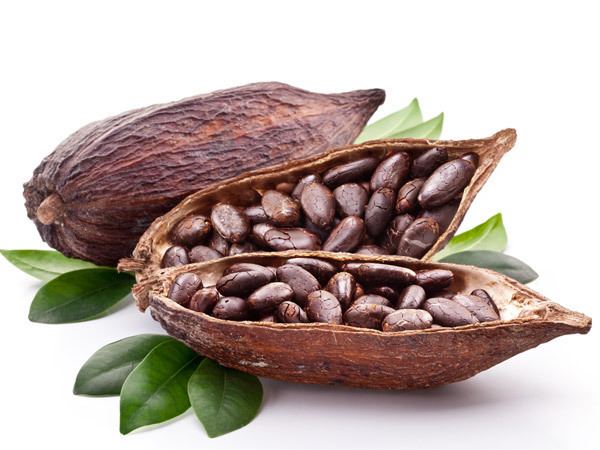 | ||
Similar Cocoa solids, Chocolate, Sugar, Vanilla, Baking powder | ||
Make fantastic chocolate from raw cocoa beans
The cocoa bean, also cacao bean or simply cocoa (/ˈkoʊ.koʊ/) or cacao (/kəˈkaʊ/), is the dried and fully fermented fatty seed of Theobroma cacao, from which cocoa solids and cocoa butter can be extracted. The "beans" are the basis of chocolate, as well as Mesoamerican foods, such as mole and tejate.
Contents
- Make fantastic chocolate from raw cocoa beans
- Etymology
- History
- Cocoa pod
- Varieties
- Harvesting
- Harvest processing
- Child slavery
- Cocoa trading
- Fair trade
- Consumption
- Chocolate production
- Health benefits
- Environmental impact
- Agroforestry
- References
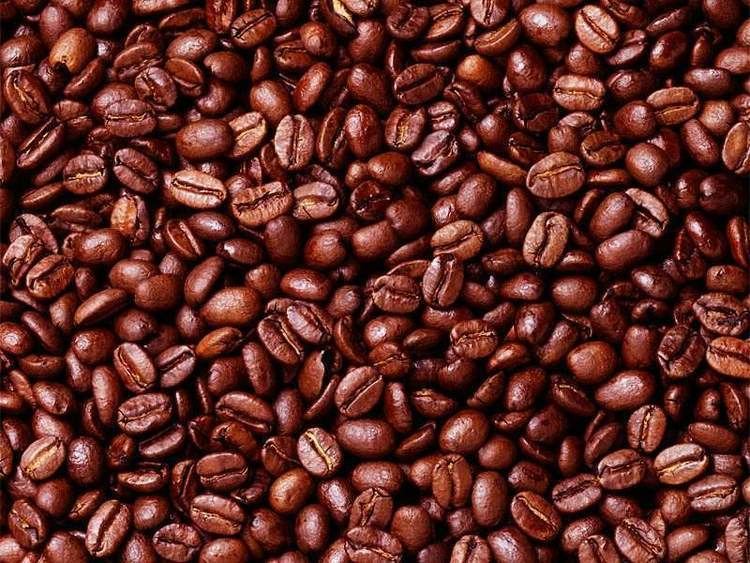
Etymology
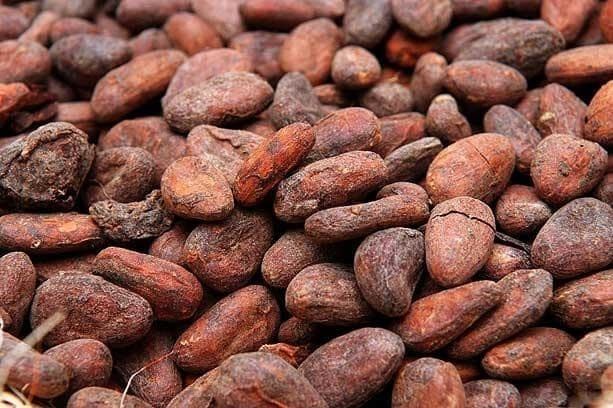
The word "cocoa" derives from the Spanish word cacao, derived from the Nahuatl word cacahuatl. The Nahuatl word, in turn, ultimately derives from the reconstructed Proto Mije-Sokean word *kakaw~*kakawa.
Cocoa can also refer to:

History
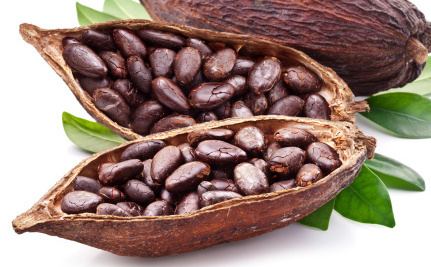
The cacao tree is native to the Americas. It originated in Central America as well as parts of Mexico. Originally over 5000 years ago, consumed by pre-Columbian cultures along the Yucatán including the Mayans, and as far back as Olmeca civilization in spiritual ceremonies. It can be found as well in the foothills of the Andes in the Amazon and Orinoco basins of South America, current-day Colombia and Venezuela. Today examples of wild cacao still can be found there. However, it may have had a larger range in the past, evidence for which may be obscured because of its cultivation in these areas long before, as well as after, the Spanish arrived. New chemical analyses of residues extracted from pottery excavated at an archaeological site at Puerto Escondido in Honduras indicate cocoa products were first consumed there between 1400 and 1500 BC. The new evidence also indicates that, long before the flavor of the cacao seed (or bean) became popular, the sweet pulp of the chocolate fruit, used in making a fermented (5% alcohol) beverage, first drew attention to the plant in the Americas. The cocoa bean was a common currency throughout Mesoamerica before the Spanish conquest.
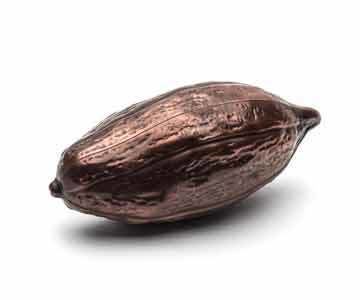
Cacao trees grow in a limited geographical zone, of about 20° to the north and south of the Equator. Nearly 70% of the world crop today is grown in West Africa. The cacao plant was first given its botanical name by Swedish natural scientist Carl Linnaeus in his original classification of the plant kingdom, who called it Theobroma ("food of the gods") cacao.
Cocoa was an important commodity in pre-Columbian Mesoamerica. A Spanish soldier who was part of the conquest of Mexico by Hernán Cortés tells that when Moctezuma II, emperor of the Aztecs, dined, he took no other beverage than chocolate, served in a golden goblet. Flavored with vanilla or other spices, his chocolate was whipped into a froth that dissolved in the mouth. No fewer than 60 portions each day reportedly may have been consumed by Moctezuma II, and 2,000 more by the nobles of his court.
Chocolate was introduced to Europe by the Spaniards, and became a popular beverage by the mid-17th century. They also introduced the cacao tree into the West Indies and the Philippines. It was also introduced into the rest of Asia and into West Africa by Europeans. In the Gold Coast, modern Ghana, cacao was introduced by an African, Tetteh Quarshie.
Cocoa pod
A cocoa pod (fruit) has a rough, leathery rind about 2 to 3 cm (0.79 to 1.18 in) thick (this varies with the origin and variety of pod) filled with sweet, mucilaginous pulp (called baba de cacao in South America) with a lemonade-like taste enclosing 30 to 50 large seeds that are fairly soft and a pale lavender to dark brownish purple color. Due to heat buildup in the fermentation process, cacao beans lose most of the purplish hue and become mostly brown in color, with an adhered skin which includes the dried remains of the fruity pulp. This skin is released easily after roasting by winnowing. White seeds are found in some rare varieties, usually mixed with purples, and are considered of higher value.
Varieties
The three main varieties of cocoa plant are Forastero, Criollo, and Trinitario. The first is the most widely used, comprising 80-90% of the world production of cocoa. Cocoa beans of the Criollo variety are rarer and considered a delicacy. Criollo plantations have lower yields than those of Forastero, and also tend to be less resistant to several diseases that attack the cocoa plant, hence very few countries still produce it. One of the largest producers of Criollo beans is Venezuela (Chuao and Porcelana). Trinitario (from Trinidad) is a hybrid between Criollo and Forastero varieties. It is considered to be of much higher quality than Forastero and has higher yields and is more resistant to disease than Criollo.
Harvesting
Cocoa trees grow in hot, rainy tropical areas within 20° of latitude from the Equator. Cocoa harvest is not restricted to one period per year and a harvest typically occurs over several months. In fact, in many countries, cocoa can be harvested at any time of the year. Pesticides are often applied to the trees to combat capsid bugs and fungicides to fight black pod disease.
Immature cocoa pods have a variety of colours, but most often are green, red, or purple, and as they mature, their colour tends towards yellow or orange, particularly in the creases. Unlike most fruiting trees, the cacao pod grows directly from the trunk or large branch of a tree rather than from the end of a branch, similar to jackfruit. This makes harvesting by hand easier as most of the pods will not be up in the higher branches. The pods on a tree do not ripen together; harvesting needs to be done periodically through the year. Harvesting occurs between three and four times weekly during the harvest season. The ripe and near-ripe pods, as judged by their colour, are harvested from the trunk and branches of the cocoa tree with a curved knife on a long pole. Care must be used when cutting the stem of the pod to avoid damaging the junction of the stem with the tree, as this is where future flowers and pods will emerge. One person can harvest an estimated 650 pods per day.
Harvest processing
The harvested pods are opened, typically with a machete, to expose the beans. The pulp and cocoa seeds are removed and the rind is discarded. The pulp and seeds are then piled in heaps, placed in bins, or laid out on grates for several days. During this time, the seeds and pulp undergo "sweating", where the thick pulp liquefies as it ferments. The fermented pulp trickles away, leaving cocoa seeds behind to be collected. Sweating is important for the quality of the beans, which originally have a strong, bitter taste. If sweating is interrupted, the resulting cocoa may be ruined; if underdone, the cocoa seed maintains a flavor similar to raw potatoes and becomes susceptible to mildew. Some cocoa-producing countries distill alcoholic spirits using the liquefied pulp.
A typical pod contains 20 to 50 beans and about 400 dried beans are required to make one pound - or 880 per kilogram - of chocolate. Cocoa pods weigh an average of 400 g (0.88 lb) and each one yields 35 to 40 g (1.2 to 1.4 oz) dried beans (this yield is 40–44% of the total weight in the pod). One person can separate the beans from about 2000 pods per day.
The wet beans are then transported to a facility so they can be fermented and dried. They are fermented for four to seven days and must be mixed every two days. They are dried for five to 14 days, depending on the climate conditions. The fermented beans are dried by spreading them out over a large surface and constantly raking them. In large plantations, this is done on huge trays under the sun or by using artificial heat. Small plantations may dry their harvest on little trays or on cowhides. Finally, the beans are trodden and shuffled about (often using bare human feet) and sometimes, during this process, red clay mixed with water is sprinkled over the beans to obtain a finer color, polish, and protection against molds during shipment to factories in the United States, the Netherlands, the United Kingdom, and other countries. Drying in the sun is preferable to drying by artificial means, as no extraneous flavors such as smoke or oil are introduced which might otherwise taint the flavor.
The beans should be dry for shipment (usually by sea). Traditionally exported in jute bags, over the last decade, beans are increasingly shipped in "mega-bulk" parcels of several thousand tonnes at a time on ships, or in smaller lots around 25 tonnes in 20-ft containers. Shipping in bulk significantly reduces handling costs; shipment in bags, however, either in a ship's hold or in containers, is still common.
Throughout Mesoamerica where they are native, cocoa beans are used for a variety of foods. The harvested and fermented beans may be ground to-order at tiendas de chocolate, or chocolate mills. At these mills, the cocoa can be mixed with a variety of ingredients such as cinnamon, chili peppers, almonds, vanilla, and other spices to create drinking chocolate. The ground cocoa is also an important ingredient in tejate and a number of savory foods, such as mole.
Nearly 4,600,000 tonnes (4,500,000 long tons; 5,100,000 short tons) of cocoa are produced annually.
The historical global production was :
1974: 1,556,484 tons,
1984: 1,810,611 tons,
1994: 2,672,173 tons,
2004: 3,607,052 tons,
2013: 4,585,552 tons.
The production increased by 194.6% in 39 years, representing a compound annual growth rate of 2.81%.
About 4.585 million tonnes of cocoa beans were produced in the 2013–2014 growing year, which runs from October to September. Of this total, African nations produced 3.014 million tonnes (65.75%), Asia and Oceania produced 0.849 million tonnes (18.52%), and the Americas produced 0.721 million tonnes (15.73%). Two African nations, Ivory Coast and Ghana, produce almost half of the world's cocoa, with 1.448 and 0.835 million tonnes, respectively (31.6% and 18.22%, respectively).
Child slavery
The first allegations that child slavery is used in cocoa production appeared in 1998. In late 2000, a BBC documentary reported the use of enslaved children in the production of cocoa in West Africa. Other media followed by reporting widespread child slavery and child trafficking in the production of cocoa. According to a report by the International Labour Organization (ILO), in 2002, more than 109,000 children were working on cocoa farms in Ivory Coast, some of them in "the worst forms of child labour". The ILO later reported that 200,000 children were working in the cocoa industry in Ivory Coast in 2005. The 2005 ILO report failed to fully characterize this problem, but estimated that up to 6% of the 200,000 children involved in cocoa production could be victims of human trafficking or slavery. In the harvest seasons of 2008/09 and 2013/14, Tulane University did researches on child labor in the West African cocoa sector. The results indicate that child labour is growing in some West African countries. In 2008/09, it was estimated that there were around 819,921 children working on cocoa farms in Ivory Coast alone, by the year 2013/14 the number went up to 1,303,009. During the same period in Ghana, the estimated number of children working on cocoa farms decreased from 997,357 to 957,398 children. The cocoa industry was accused of profiting from child slavery and trafficking. The Harkin-Engel protocol is an effort to end these practices. It was signed and witnessed by the heads of eight major chocolate companies, Harkin, Engel, US Senator Herb Kohl, the ambassador of the Ivory Coast, the director of the International Programme on the Elimination of Child Labor, and others. It has, however, been criticized by some groups including the International Labor Rights Forum as an industry initiative which falls short.
Cocoa trading
Cocoa beans from Ghana are traditionally shipped and stored in burlap sacks, in which the beans are susceptible to pest attacks. Fumigation with methyl bromide was to be phased out globally by 2015. Additional cocoa protection techniques for shipping and storage include the application of pyrenoids as well as hermetic storage in sealed bags or containers with lowered oxygen concentrations. Safe long-term storage facilitates the trading of cocoa products at commodity exchanges.
Cocoa beans, cocoa butter and cocoa powder are traded on two world exchanges: ICE Futures U.S. and NYSE Liffe Futures and Options. The London market is based on West African cocoa and New York on cocoa predominantly from Southeast Asia. Cocoa is the world's smallest soft commodity market.
The future price of cocoa butter and cocoa powder is determined by multiplying the bean price by a ratio. The combined butter and powder ratio has tended to be around 3.5. If the combined ratio falls below 3.2 or so, production ceases to be economically viable and some factories cease extraction of butter and powder and trade exclusively in cocoa liquor.
Fair trade
Fair trade in cocoa is an important point in the cocoa industry. Customers are more interested in fairly traded goods. Many will investigate in fair trade now to improve the conditions of farmers on cocoa plants. In 2016 it was reported that the chocolate producer Ferrero will further invest in fair trade; the plan is to double the amount of cocoa originating from fair trade in the upcoming 3 years. Ferrero wants to invest in 40.000 MT of fair trade cocoa till 2020.
Fair trade cocoa producer groups are established in Belize, Bolivia, Cameroon, the Congo, Costa Rica, the Dominican Republic, Ecuador, Ghana, Haiti, India, Ivory Coast, Nicaragua, Panama, Peru, Sierra Leone, and São Tomé and Príncipe. As of 2014, less than 1% of the chocolate market was fair trade. Cadbury, one of the world's largest chocolate companies, has begun certifying its Dairy Milk bars as fair trade; according to Cadbury, in 2010 "around one quarter of ... global sales" of these bars will be fair trade. In 2007, the United States imported approximately 1.95 million pounds of fairly traded cocoa.
In order to purpose a sustainable and responsible coffee-production, established 1997 the Dutch coffee roaster Ahold Coffee Company in cooperation with coffeefarmers, the UTZ Certified-programme. To achieve this, they created the utz-certificate, which includes the counteracting against child labor and the exploitation of the workers. To receive this certificate, the included farm/company needs to follow a code of conduct in relation to social and environmental friendly factors. Furthermore, the UTZ-program focuses on an improvement of farming methods to increase the profits and salaries of farmers and distributors on site.
Dutch investigative reporter Teun van de Keuken started a new chocolate company in 2005 called Tony's Chocolonely wholly dedicated to slave free and fair trade chocolate when his research unveiled the poor state of fair trade among companies that had previously signed the Harkin-Engel protocol.
Cocoa Life Program: FLO-Cert, a company established in 1997, which is working for the improvement of labelled Fairtrade and Mondelēz International, the third greatest food producer in the world, launched in 2012 the Cocoa Life Program. Because the conditions for cocoa farmers haven’t changed much in the past 50 years, it is necessary to improve the supply chain. The Cocoa Life Program invests $400m in its cocoa supply chain over the next ten years. Approximately $100m of the money will be spent for the cocoa supply chain in Ivory Coast. This will improve the life of about 75.000 farmers. Furthermore, $100m will be spent to Ghana and the remaining $200m will be shared between Brazil, Dominican Republic and India. The company is not only investigating in the purchase of certificated cocoa, but focus more on the direct investment in the cocoa supply chain. The long-term goal of the Cocoa Life Program are: higher incomes for farmers, authorization, inspiring young people and conserving the environment.
Consumption
People around the world enjoy cocoa in many different forms, consuming more than 3 million tons of cocoa beans yearly. Every consumer has a unique taste and preferences of the end product. Once the cocoa beans have been harvested, fermented, dried and transported they are processed in several components. Processor grindings serve as the main metric for market analysis. Processing is the last phase in which consumption of the cocoa bean can be equitably compared to supply. After this step all the different components are sold across industries to many manufacturers of different types of products.
Global market share for processing has remained stable, even as grindings increase to meet demand. One of the largest processing country by volume is the Netherlands, handling around 13% of global grindings. Europe and Russia as a whole handle about 38% of the processing market. Average year after year demand growth has been just over 3% since 2008. While Europe and North America are relatively stable markets, increasing household income in developing countries is the main reason of the stable demand growth. As demand is awaited to keep growing, supply growth may slow down due to changing weather conditions in the largest cocoa production areas.
Chocolate production
To make 1 kg (2.2 lb) of chocolate, about 300 to 600 beans are processed, depending on the desired cocoa content. In a factory, the beans are roasted. Next, they are cracked and then deshelled by a "winnower". The resulting pieces of beans are called nibs. They are sometimes sold in small packages at specialty stores and markets to be used in cooking, snacking, and chocolate dishes. Since nibs are directly from the cocoa tree, they contain high amounts of theobromine. Most nibs are ground, using various methods, into a thick, creamy paste, known as chocolate liquor or cocoa paste. This "liquor" is then further processed into chocolate by mixing in (more) cocoa butter and sugar (and sometimes vanilla and lecithin as an emulsifier), and then refined, conched and tempered. Alternatively, it can be separated into cocoa powder and cocoa butter using a hydraulic press or the Broma process. This process produces around 50% cocoa butter and 50% cocoa powder. Standard cocoa powder has a fat content around 10–12%. Cocoa butter is used in chocolate bar manufacture, other confectionery, soaps, and cosmetics.
Treating with alkali produces Dutch-process cocoa powder, which is less acidic, darker, and more mellow in flavor than what is generally available in most of the world. Regular (nonalkalized) cocoa is acidic, so when cocoa is treated with an alkaline ingredient, generally potassium carbonate, the pH increases. This process can be done at various stages during manufacturing, including during nib treatment, liquor treatment, or press cake treatment.
Another process that helps develop the flavor is roasting, which can be done on the whole bean before shelling or on the nib after shelling. The time and temperature of the roast affect the result: A "low roast" produces a more acid, aromatic flavor, while a high roast gives a more intense, bitter flavor lacking complex flavor notes.
Health benefits
In general, cocoa is considered to be a rich source of antioxidants such as procyanidins and flavanoids, which may impart antiaging properties. Cocoa also contain a high level of flavonoids, specifically epicatechin, which may have beneficial effects on cardiovascular health. Cocoa is a stimulant and contains the compounds theobromine and caffeine. The beans contain between 0.1% and 0.7% caffeine, whereas dry coffee beans are about 1.2% caffeine.
The stimulant activity of cocoa comes from the compound theobromine which is less diuretic as compared to theophylline found in tea. Prolonged intake of flavanol-rich cocoa has been linked to cardiovascular health benefits, though this refers to raw cocoa and to a lesser extent, dark chocolate, since flavonoids degrade during cooking and alkalizing processes. Short-term benefits in LDL cholesterol levels from dark chocolate consumption have been found. The addition of whole milk to milk chocolate reduces the overall cocoa content per ounce while increasing saturated fat levels. Although one study has concluded that milk impairs the absorption of polyphenolic flavonoids, e.g. epicatechin, a followup failed to find the effect.
Hollenberg and colleagues of Harvard Medical School studied the effects of cocoa and flavanols on Panama's Kuna people, who are heavy consumers of cocoa. The researchers found that the Kuna people living on the islands had significantly lower rates of heart disease and cancer compared to those on the mainland who do not drink cocoa as on the islands. It is believed that the improved blood flow after consumption of flavanol-rich cocoa may help to achieve health benefits in hearts and other organs. In particular, the benefits may extend to the brain and have important implications for learning and memory.
Foods rich in cocoa appear to reduce blood pressure, but drinking green and black tea may not, according to an analysis of previously published research in the April 9, 2007 issue of Archives of Internal Medicine.
A 15-year study of elderly men published in the Archives of Internal Medicine in 2006 found a 50 percent reduction in cardiovascular mortality and a 47 percent reduction in all-cause mortality for the men regularly consuming the most cocoa, compared to those consuming the least cocoa from all sources.
Environmental impact
The relative poverty of many cocoa farmers means that environmental consequences such as deforestation are given little significance. For decades, cocoa farmers have encroached on virgin forest, mostly after the felling of trees by logging companies. This trend has decreased as many governments and communities are beginning to protect their remaining forested zones. In general, the use of chemical fertilizers and pesticides by cocoa farmers is limited. When cocoa bean prices are high, farmers may invest in their crops, leading to higher yields which, in turn tends to result in lower market prices and a renewed period of lower investment.
Cocoa production is likely to be affected in various ways by the expected effects of global warming. Specific concerns have been raised concerning its future as a cash crop in West Africa, the current centre of global cocoa production. If temperatures continue to rise, West Africa could simply become unfit to grow the beans.
Agroforestry
Cocoa beans may be cultivated under shaded conditions, e.g. agroforestry. Agroforestry can reduce the pressure on existing protected forests for resources, such as firewood, and conserve biodiversity. Agroforests act as buffers to formally protected forests and biodiversity island refuges in an open, human-dominated landscape. Research of their shade-grown coffee counterparts has shown that greater canopy cover in plots is significantly associated to greater mammal species richness and abundance. The amount of diversity in tree species is fairly comparable between shade-grown cocoa plots and primary forests. Farmers can grow a variety of fruit-bearing shade trees to supplement their income to help cope with the volatile cocoa prices. Though cocoa has been adapted to grow under a dense rainforest canopy, agroforestry does not significantly further enhance cocoa productivity.
